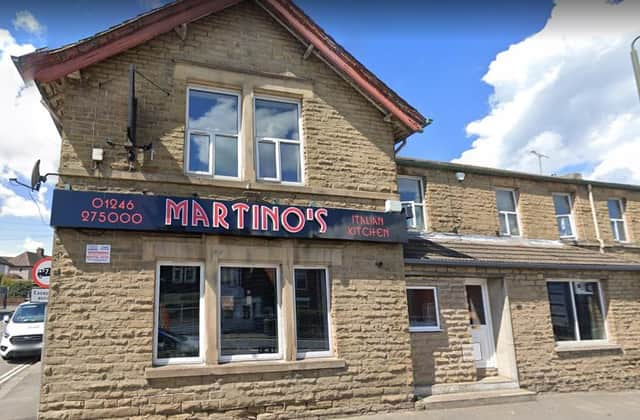Secret tunnels of Chesterfield are exposed by historian


The discovery of an entrance to an underground tunnel at The Hidden Knight pub on Soresby Street has sparked a flood of postings on the Derbyshire Times Facebook site.
Joanne Cutts says: “There are tunnels all over town coming from most of the old pubs, towards the spire, it's one of the most famous and interesting facts about Chesterfield history.”
Advertisement
Hide AdAdvertisement
Hide AdZetty Bailey posts: “There are tunnels linked all the way to Birdholme. I used to live in The Furnace pub (now a restaurant) on Derby Road when I was little. Down the cellar there is a tunnel with loads of doors either side all the way to town but it's collapsed part way.”
Historian Philip Riden, who is chairman of Chesterfield and district Civic Society, said that the stories of secret tunnels in the town began circulating in Victorian times.
He said: “The favourite tends to be a secret passage from the leper hospital in Spital to the parish church to attend services secretly.
"Others I have come across are stories of similar secret passages to the church from 9 Beetwell Street, 89 New Square (which is sometimes wrongly called a ‘manor house’) and (incredibly) from Walton Hall to the church.”
Advertisement
Hide AdAdvertisement
Hide AdBut Philip, who is co-author of Chesterfield Streets and Houses, said that the secret tunnels are a complete myth.
“Why anyone ever imagined there would be a tunnel about two miles long from Walton Hall to the church I do not know,” he said. “The most likely explanation is that the cellars of the present late 18th-century house on the site of Walton Hall extend further than the footprint of that house because they belong to the very much larger 16th-century mansion that stood on the same site, and so might look like the beginnings of a tunnel. The same might be true of cellars beneath 9 Beetwell Street.
"Apart from a misunderstanding of cellars, another possible reason why Victorian antiquaries believed in stories of secret tunnels is because there were drainage tunnels (known as soughs) at some of the collieries around Chesterfield.
"The word sough is more commonly associated with lead mines in the Peak District but the term is also used of tunnels built to drain water from collieries, so as to enable the coal to be worked to a lower level. They were expensive to build but once built they drained the colliery more cheaply than using a steam pumping engine.
Advertisement
Hide AdAdvertisement
Hide Ad“Small-scale soughs at coalpits round Chesterfield go back to at least the 16th century. There was a dispute in the 1570s between Godfrey Foljambe of Walton Hall and Francis Leake of Sutton over a sough which Godfrey had built to drain his pits on Brimington Common. This drained into Trough Brook, near Leake's land at Westwood, to which he understandably objected. There were probably other soughs of the same period of which no record survives, for example draining mines at Walton into the Hipper, or around Tapton into the Rother.
"I also know of one local reference to a medieval coal mine sough, which was built by the tenants of Welbeck Abbey to drain their pits on Duckmanton Moor. I am fairly certain this ran partly on the surface and appears to be the watercourse which in the late 18th century was widened to become a small tub-boat canal that ran from the Adelphi Ironworks at Duckmanton to a wharf of the road from Duckmanton to Staveley. There was also an underground canal at Hollingwood, which brought coal to the Chesterfield Canal.
“There is at least one 19th-century instance of a colliery company building a heading from one pit to another over a considerable distance (as opposed to joining up underground two adjoining collieries, which was done more commonly to economise on surface installations). This was a tunnel built from Wallsend colliery in Newbold to Tapton colliery near Lockoford Lane, a distance of about 2,000 yards, in the 1860s. The idea was to send coal mined at Wallsend (which had no railway connection) by tram (running downhill by gravity, with rope haulage in the opposite direction) to Tapton to be brought up the shaft there, since Tapton colliery stood alongside the Midland Railway. It was very expensive to build and helped to ruin the Tapton Coal Company which built it.
“These soughs would have collapsed once the collieries they served closed. It is possibly that remains might be exposed during opencast coal working, or during land reclamation on former opencast sites, or during other building work, and that people might imagine that they were much older than they are. In the Peak District soughs survive because they were cut through solid rock, but in the coalfield this is very unlikely to be the case. Lead mining soughs have been traced and mapped by local historians, but there isn't much scope for doing that with soughs built to drain collieries.”
Advertisement
Hide AdAdvertisement
Hide AdPhilip is the author of 60 academic books, edited texts, pamphlets and articles, mainly on industrial history and local history, especially Derbyshire.
A message from Phil Bramley. editor
Support your Derbyshire Times by becoming a digital subscriber. You will see 70 per cent fewer ads on stories, meaning faster load times and an overall enhanced user experience. Click here to subscribe.
